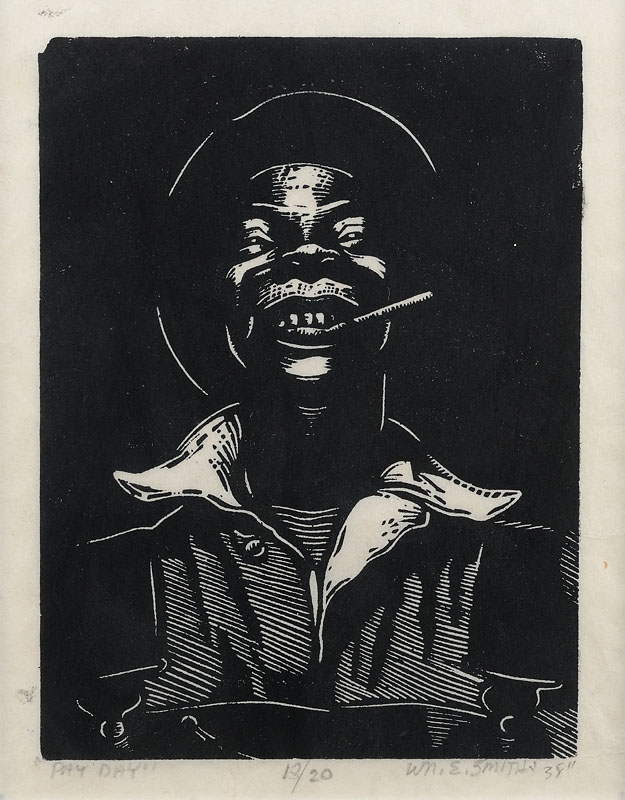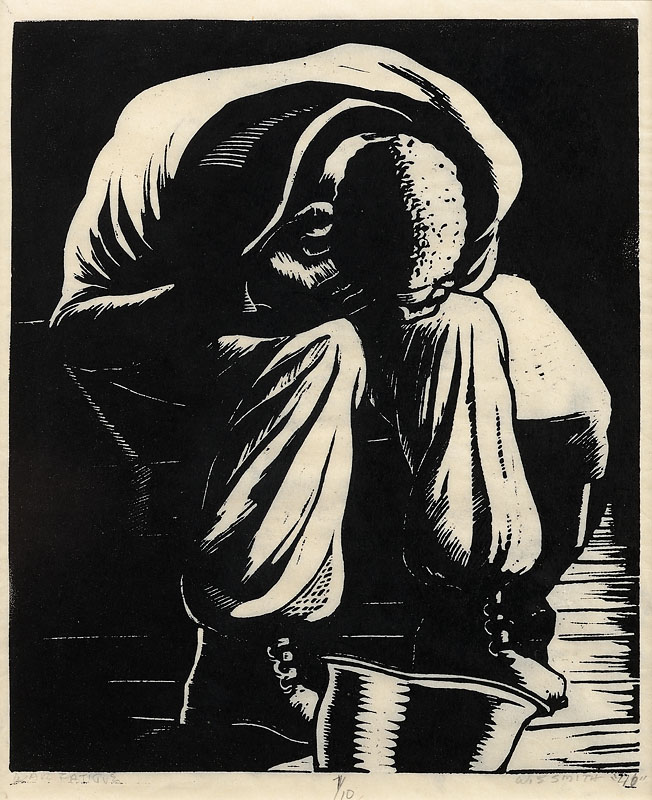William E. Smith (1913-1997)
WILLIAM E. SMITH (1913-1997)
When William Elijah Smith was twelve, his mother died. His poor but supportive world in Chattanooga, Tennessee, ended and he traveled with his younger sister and brother to Cleveland to be with their father. In the early 1930s, still a teenager, having broken with his father, and living on his own in extreme hardship, Smith met Rowena and Russell Jelliffe, founders of Karamu House. They not only aided him financially but opened his world to the creative possibilities of their settlement house.
Originally known as the Playhouse Settlement, Karamu was then located at 38th Street and Central Avenue in Cleveland, and its philosophy stressed a commitment to excellence. In this inter-racial environment Smith, who was African American, worked with Marion Bonsteel, a graduate of the Cleveland Art Institute, and with Richard Beatty, who studied at the Carnegie Institute. Smith himself taught at Karamu until 1940. Karamu was well respected in Cleveland, especially for its strong performing arts programs that including theater, marionettes, and dance. At Karamu, Smith"s circle included Marjorie Witt Johnson. Her famous Karamu Dancers performed at the New York Worlds Fair in 1940, and she remained a support throughout his career.
It was at Karamu that Smith discovered printmaking and gained access to the brown battleship linoleum, from which he made linocuts. These prints are a highlight of his oeuvre and it is largely through them and their multiplicity that his work is known.
Smith showed at the Cleveland Artists Exhibitions at the Cleveland Museum of Art, in the 1930s and 40s. He was one of the Karamu Artists, Incorporated, along with Elmer W. Brown, Fred Carlo, Hughie Lee-Smith, Zell Ingram, Charles Sallee, Curtis Tann, Thomas Usher, and William Hulsinger. They participated in numerous Karamu exhibitions, including a major show at Associated American Artists, New York, that opened January 7, 1942, with Eleanor Roosevelt as the Honorary National Chairman.
From 1935 to 1940 Smith also attended the John Huntington Polytechnic Art Institute in Cleveland on a five-year Gilpin Scholarship named for the famous black actor, Charles Gilpin. During World War II Smith served in the United States Army, possibly with an all-black unit that participated in the famous Red Ball Express, a transportation and supply mission in France. In 1944, he won a trip to Paris in a GI art contest on the theme, How to Fight Mud as Well as Nazis.
After the War Smith attended the Cleveland School of Art (now the Cleveland Institute of Art) where he studied with Paul Travis, and Hal Cooper"s School of Advertising. He moved to Los Angeles in around 1950. There he worked nights in the sign division of Lockheed Aircraft, attended the Chouinard Art Institute, 1956-60, and also taught classes in his studio for many years. He co-founded and exhibited with the Eleven Associated Artists" Gallery (originally the Black Artists" Gallery), in the 1950s; and in the Afro-American Art Exhibit (the Marian Matthews Collection), Los Angeles, 1969. Around this time his work was also featured at the Florenz Gallery, Hollywood.
Linocuts by Smith were included in Impressions/Expressions: Black American Graphics, the Studio Museum in Harlem, New York, 1979/80, and the Gallery of Art, Howard University, Washington, DC, 1980, and Alone in a Crowd, Prints of the 1930s and 40s by African-American Artists from the Collection of Reba and Dave Williams. That show traveled to the Equitable Gallery, New York, and the Newark Museum of Art, New Jersey, 1992, the Long Beach Museum of Art, California, 1993, the New York State Museum, and Yale University Art Gallery, Hartford, Connecticut, 1994, and the Brooklyn Museum, New York, 1996. This collection is now in the Metropolitan Museum of Art, New York.
Work by Smith was shown in The Russell and Rowena Jelliffe Collection: Prints & Drawings from the Karamu Workshop, 1929-1941, South Wing Gallery, St. Paul"s Episcopal Church, Cleveland Heights, 1991. In 1994 the exhibition was expanded to show the entire Jelliffe collection at the Cleveland State University Art Gallery, where it is now housed. Later in the 1990s the title of an exhibition, Yet Still We Rise, African American Art in Cleveland, 1920-1970, was a paraphrase taken from the Smith painting, ...And Yet I Still Rise, 1970. His watercolor, 38th and Central, 1942 (the location of Karamu House), was on the cover of the catalogue. The show traveled to Cleveland State University, 1996, the Butler Institute of American Art, Youngstown, and the Riffe Gallery, Columbus, 1997.
The exhibition, William E. Smith, Drawings and Linocuts, was on view at the Susan Teller Gallery, 2001. One-man shows of his work were also held at the Hull House, 1946, and Lyman Gallery, 1947, both in Chicago. The exhibition The Printmaker, From Umbrella Staves to Brush and Easel, was held at the Afro-American, Historical Society, Cleveland, 1976.
By far the largest archive of work by William E. Smith is found at the Cleveland State University Art Gallery where it is part of the Jelliffe Collection. Other the permanent collections with work by Smith are the Metropolitan Museum of Art, NY, the Syracuse University Art Gallery, NY, the Cleveland Museum of Art and the Oberlin College Art Museum, and the Gallery of Art, Howard University, and the Library of Congress, Washington, DC.
Bio courtesy of the Susan Teller Gallery. Link to bio: http://www.susantellergallery.com/cgi/STG_art.pl?artist=smith

Pay Day
Linocut
8x6 inches
1938
Signed and dated
Photo credit: John Wilson White Studio

Poverty and Fatigue
Linocut
10 3/4x8 7/8 inches
1940
Signed
Photo credit: John Wilson White Studio

War Fatigue (American)
Linocut
9x8 inches
1940
Signed
Photo credit: John Wilson White Studio